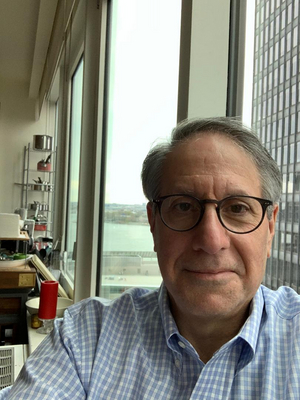Interview: The Most Powerful Voice in DC Area Theatre Peter Marks on Covering the Arts When the Arts are Basically Shut Down

Towards the end of the musical A Chorus Line, the director/choreographer asks of his auditioning dancers "What are you going to do when you can't dance anymore?"
The COVID-19 outbreak has affected everybody without question. Social distancing, face masks, and quarantining ourselves have become the "new normal." It's anything but that!
For those of us that work in the arts, we are faced with a similar question as those dancers in A Chorus Line are. How do you create art when the arts are basically shuttered? That question becomes even more complicated when you make your living writing about the arts for a top publication.
Peter Marks is unquestionably the most powerful voice in DC area theatre. He has been the chief theatre critic for The Washington Post since 2002. You can also currently hear him on the podcast series Three on the Aisle with his colleagues Terry Teachout of The Wall Street Journal and former New York Post critic Elizabeth Vincentelli.
Much of Peter's job involves sitting in the dark critiquing area and Broadway productions. The outbreak has derailed that for the foreseeable future.
These days, Peter is quarantining in his NYC apt looking at a gorgeous view. I am so jealous.
Read on to see how he is coping along with the rest of us and also what he thinks theatre will be like when it is allowed to resume.
Stay safe everyone!
Through the years, the arts have always managed to survive human tragedies and come back even stronger afterwards. What do you think makes this pandemic different in terms of arts organizations being able to re-open after we get the all clear?
After 9/11, there was a brief interlude in which it was thought people would be afraid to gather again. It turned out that the opposite was true, and in that case, returning to the theater was an act of defiant solidarity: we weren't going to let a horrific act inhibit our freedom. A fatal contagion with no cure presents a higher hurdle; there's no honor in ignoring the safety guidelines. After the all-clear, theaters will have to take radical measures to ensure our peace of mind. Many theatergoers will need extraordinary reassurance that the risks have been eliminated.
This pandemic has affected all facets of the arts including those of us that cover it. How do you cover the arts scene when there isn't almost any art left to cover? How creative have you had to get in order to make sure the Washington Post has arts content?
I am, as always, a busy boy. I've written articles about the effects of the shutdown, as well as about the theater community's responses. I collaborated with several critics and reporters in Style on a piece that ran on page one about the devastation wreaked on New York City as a global arts magnet. I've written critically, too, about some of what I've seen in the migration of filmed plays to the digital world. Of late, I'm looking at an evolving genre -- Zoom Theater -- and finding that theater artists are both writing for it and developing techniques that use it inventively.
Back in the day, before becoming a theatre critic, you covered such events as the Exxon Valdez mess. If your publication needed you to switch gears for a bit, would you have any trepidation about covering the pandemic from a non-arts angle?
I am game for whatever needs to be done. The Washington Post has done extraordinary reporting in the field under harrowing circumstances. Living in New York through this makes one keenly aware of the scale of the crisis. Keeping people informed about what is happening to the culture may not be as central as tallying the toll in lives. But for a lot of readers, the arts are vital to what makes life worth living. So I'll keep at that till I'm asked to take on other assignments.
Like most of us, you are quarantining at home. What are you doing to pass the time when you are not writing something or doing your Three on the Aisle podcast?
I'm ironing. It's a very Zen pursuit. A shirt with crisp lines smoothes things for me in an upsettingly wrinkled world. Also, I've been reading a lot of books and watching a ton of streaming TV, including a riveting 73-part (!) French series about a village in France during and after the Nazi occupation, called Un Village Francais. It's on Hulu and MHz.
When theatres are able to open again do you think audiences will come back immediately or will it take some time for some everyone to feel comfortable again sitting in a darkened theatre very close to other people?
Mark Shugoll, a DC market research expert, just did a survey that indicated the vast majority of people would wait a few months before returning. My feeling is people will return when the fear of missing out overwhelms the fear of being in close quarters. Someone who's waited to see Hamilton, e.g.. is more likely to push forward their timeline for returning than someone just thinking about theater in the abstract.
When this is all over, what will be your first post pandemic arts article be?
It'll be a review of the musical I saw just before this calamity began to play out. I wrote it on the day that Broadway shuttered. It's been sitting in a computer, waiting -- impatiently -- for its cue.
Comments
Videos

